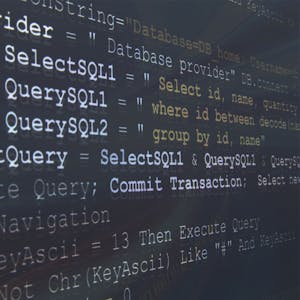SQL for Data Science
As data collection has increased exponentially, so has the need for people skilled at using and interacting with data; to be able to think critically, and provide insights to make better decisions and optimize their businesses. This is a data scientist, “part mathematician, part computer scientist, and part trend spotter” (SAS Institute, Inc.). According to Glassdoor, being a data scientist is the best job in America; with a median base salary of $110,000 and thousands of job openings at a time. The skills necessary to be a good data scientist include being able to retrieve and work with data, and to do that you need to be well versed in SQL, the standard language for communicating with database systems.This course is designed to give you a primer in the fundamentals of SQL and working with data so that you can begin analyzing it for data science purposes. You will begin to ask the right questions and come up with good answers to deliver valuable insights for your organization. This course starts with the basics and assumes you do not have any knowledge or skills in SQL. It will build on that foundation and gradually have you write both simple and complex queries to help you select data from tables. You’ll start to work with different types of data like strings and numbers and discuss methods to filter and pare down your results.
You will create new tables and be able to move data into them. You will learn common operators and how to combine the data. You will use case statements and concepts like data governance and profiling. You will discuss topics on data, and practice using real-world programming assignments. You will interpret the structure, meaning, and relationships in source data and use SQL as a professional to shape your data for targeted analysis purposes.
Although we do not have any specific prerequisites or software requirements to take this course, a simple text editor is recommended for the final project. So what are you waiting for? This is your first step in landing a job in the best occupation in the US and soon the world!
Identify a subset of data needed from a column or set of columns and write a SQL query to limit to those results.
Use SQL commands to filter, sort, and summarize data.
Create an analysis table from multiple queries using the UNION operator.
Manipulate strings, dates, & numeric data using functions to integrate data from different sources into fields with the correct format for analysis.
Syllabus
Syllabus - What you will learn from this course
Week 1
Getting Started and Selecting & Retrieving Data with SQL
Week 2
Filtering, Sorting, and Calculating Data with SQL
Week 3
Subqueries and Joins in SQL
Week 4
Modifying and Analyzing Data with SQL
FAQ
When will I have access to the lectures and assignments?
Access to lectures and assignments depends on your type of enrollment. If you take a course in audit mode, you will be able to see most course materials for free. To access graded assignments and to earn a Certificate, you will need to purchase the Certificate experience, during or after your audit. If you don't see the audit option:
What will I get if I subscribe to this Specialization?
When you enroll in the course, you get access to all of the courses in the Specialization, and you earn a certificate when you complete the work. Your electronic Certificate will be added to your Accomplishments page - from there, you can print your Certificate or add it to your LinkedIn profile. If you only want to read and view the course content, you can audit the course for free.
Is financial aid available?
Yes. In select learning programs, you can apply for financial aid or a scholarship if you can’t afford the enrollment fee. If fin aid or scholarship is available for your learning program selection, you’ll find a link to apply on the description page.
Reviews
The contents and explanations on the course are good, even for people with no previews coding experience (like me)... Would be great to have a better structured way of work for the final excercise
Thank you for the material that was presented well and clearly. I got to know better how to use SQL for data science. Hopefully, by learning this, I can implement it in the future as a Data Analyst.
Great course for beginners, very clear and instructor share useful tips. The only reason I don't give it 5 stars is because I think there could be more material related to date and time functions.
Please Included examples while the instructor is teaching in the video lectures. The instructor is very talented in teaching but due to lack of examples in the video it downgrades the overall course.
